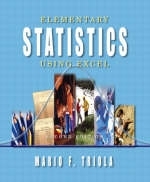
Elementary Statistics Using Excel
Pearson (Verlag)
978-0-201-77569-3 (ISBN)
- Titel erscheint in neuer Auflage
- Artikel merken
Elementary Statistics Using Excel is a complete introduction to basic statistics, with a strong emphasis on understanding statistics concepts and the inclusion of Excel spreadsheet technology for the analysis of data. Statistics topics are presented with illustrative examples, identification of required assumptions, and underlying theory. Excel instructions (based on Excel 2002) are provided along with typical displays of results, and information about Excel's limitations and alternative approaches. The CD-ROM included with each copy of the book includes DDXL, a software add-in that enhances and expands the capability of Excel, as well as the Appendix B data sets in the form of Excel workbooks.
(Each Chapter begins with an Overview.).
1. Introduction to Statistics.
Types of Data.
Critical Thinking.
Design of Experiments.
Introduction to Excel.
2. Describing, Exploring, and Comparing Data.
Frequency Distributions.
Visualizing Data.
Measures of Center.
Measures of Variation.
Measures of Relative Standing.
Exploratory Data Analysis (EDA).
3. Probability.
Fundamentals.
Addition Rule.
Multiplication Rule: Basics.
Multiplication Rule: Complements and Conditional Probability.
Probabilities Through Simulations.
Counting.
4. Probability Distributions.
Random Variables.
Binomial Probability Distributions.
Mean, Variance, and Standard Deviation for the Binomial Distribution.
The Poisson Distribution.
5. Normal Probability Distributions.
The Standard Normal Distribution.
Applications of Normal Distributions.
Sampling Distributions and Estimators.
The Central Limit Theorem.
Normal as Approximation to Binomial.
Determining Normality.
6. Estimates and Sample Sizes.
Estimating a Population Proportion.
Estimating a Population Mean: s known.
Estimating a Population Mean: s not known.
Estimating a Population Variance.
7. Hypothesis Testing.
Basics of Hypothesis Testing.
Testing a Claim about a Proportion.
Testing a Claim about a Mean: s known.
Testing a Claim about a Mean: s not known.
Testing a Claim about Standard Deviation or Variance.
8. Inferences from Two Samples.
Inferences about Two Proportions.
Inferences about Two Means: Independent Samples.
Inferences from Matched Pairs.
Comparing Variation in Two Samples.
9. Correlation and Regression.
Correlation.
Regression.
Variation and Prediction Intervals.
Multiple Regression.
Modeling.
10. Multinomial Experiments and Contingency Tables.
Multinomial Experiments: Goodness-0f-Fit.
Contingency Tables: Independence and Homogeneity.
11. Analysis of Variance.
One-Way ANOVA.
Two-Way ANOVA.
12. Nonparametric Statistics.
Overview.
Sign Test.
Wilcoxon Signed-Ranks Test for Matched Pairs.
Wilcoxon Rank-Sum Test for Two Independent Samples.
Kruskal-Wallis Test.
Rank Correlation.
Runs Test for Randomness.
13. Statistical Process Control.
Control Charts for Variation and Mean.
Control Charts for Attributes.
14. Projects, Procedures, Perspectives.
Projects.
Procedure.
Perspective.
Appendices.
Appendix A: Tables.
Appendix B: Data Sets.
Appendix C: Excel Reference.
Appendix D: Glossary.
Appendix E: Bibliography.
Appendix F: Answers to Odd-Numbered Exercises (and All Review Exercises and All Cumulative Review Exercises).
Credits.
| Erscheint lt. Verlag | 14.8.2003 |
|---|---|
| Sprache | englisch |
| Maße | 212 x 258 mm |
| Gewicht | 1987 g |
| Themenwelt | Informatik ► Office Programme ► Excel |
| Mathematik / Informatik ► Mathematik ► Computerprogramme / Computeralgebra | |
| ISBN-10 | 0-201-77569-7 / 0201775697 |
| ISBN-13 | 978-0-201-77569-3 / 9780201775693 |
| Zustand | Neuware |
| Informationen gemäß Produktsicherheitsverordnung (GPSR) | |
| Haben Sie eine Frage zum Produkt? |
aus dem Bereich


